The family transportation, the convenience of third-row seating has become increasingly important for growing families and those who frequently transport multiple passengers.
While third-row seats offer valuable additional capacity, their usability depends significantly on the ease with which they can be folded to accommodate cargo when not needed for passengers.
One often overlooked yet crucial aspect of this functionality is whether the headrests need to be removed or adjusted before folding the seats.
Vehicles that allow third-row seats to fold flat without headrest removal offer superior convenience and time-saving benefits, eliminating a frustrating extra step in the process of reconfiguring your vehicle’s interior space.
This comprehensive guide explores ten standout vehicles featuring ingeniously designed third-row seats that fold seamlessly without requiring headrest removal or adjustment.
From spacious family SUVs to versatile crossovers, these vehicles represent the pinnacle of interior engineering that prioritizes user convenience. We’ll examine their unique folding mechanisms, cargo capabilities, third-row passenger comfort, and additional features that enhance their functionality.
Whether you’re shopping for a new family vehicle or simply curious about the latest innovations in automotive interior design, this guide will help you understand the significant advantages these thoughtfully engineered third-row seating systems provide.
1. Honda Pilot
The Honda Pilot stands as a paragon of thoughtful engineering in the midsize SUV segment, particularly when it comes to its third-row seating system.
This three-row family hauler has consistently refined its interior functionality over successive generations, culminating in one of the most user-friendly third-row folding mechanisms on the market today.
What sets the Pilot apart is its ingeniously designed third-row seats that fold completely flat without requiring any headrest removal or adjustment, a convenience that becomes immediately apparent during everyday use.
The Pilot’s third-row folding system utilizes a one-touch mechanism activated by pulling a single strap, causing the headrests to automatically tuck away as the seatback folds down.
This elegant solution eliminates the common frustration of having to manually remove headrests and find storage space for them, a particularly welcome feature when you’re already juggling groceries, sports equipment, or luggage.
The system’s fluid operation means transitioning from passenger configuration to cargo mode takes mere seconds rather than minutes, highlighting Honda’s commitment to real-world usability.
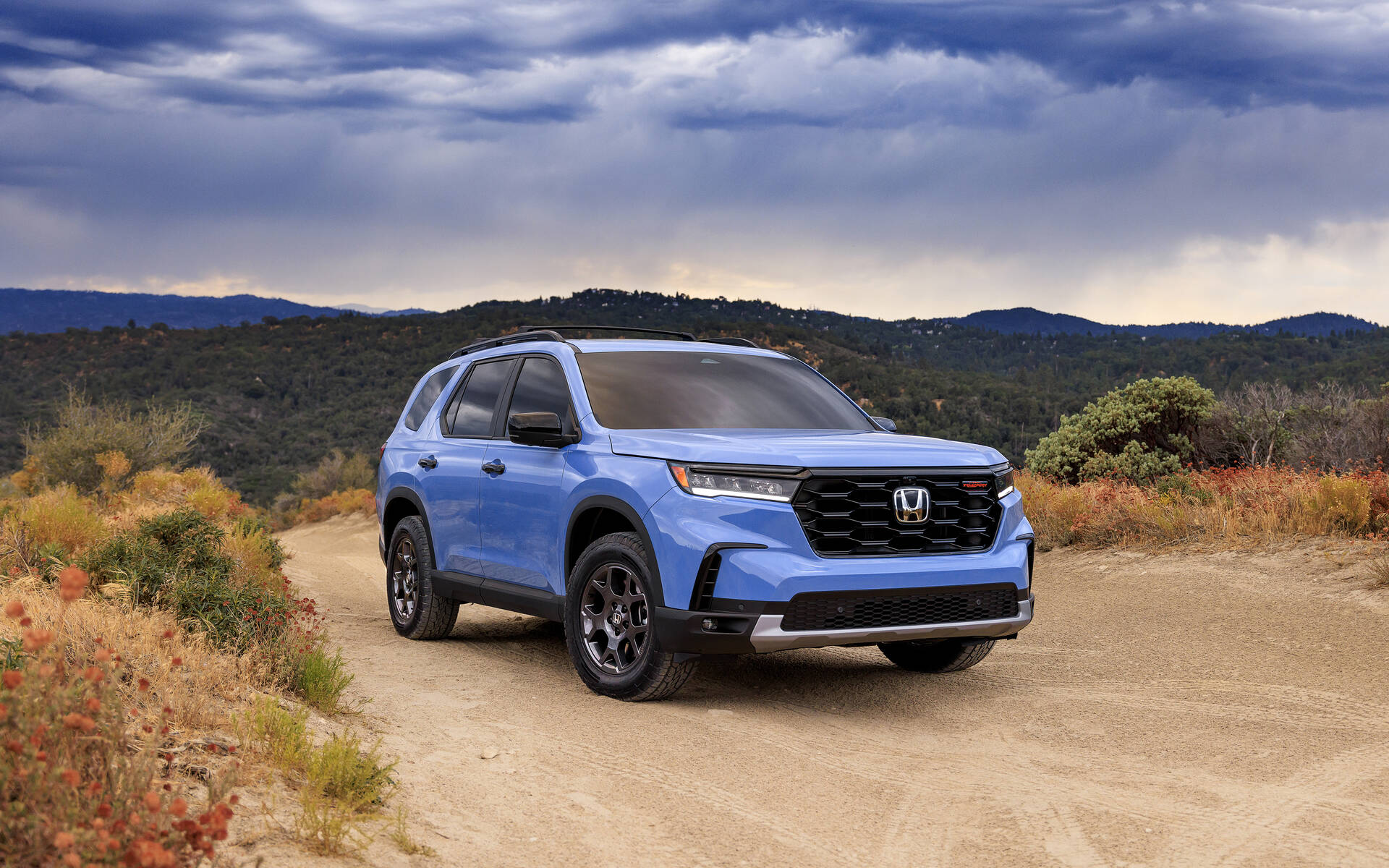
Beyond the convenience of its folding mechanism, the Pilot’s third row merits praise for its substantial dimensions. Unlike many competitors, where the third row feels like an afterthought, Honda has allocated sufficient width and legroom to accommodate adult passengers comfortably.
The headrests themselves are positioned at a proper height for passenger safety without interfering with the driver’s rearward visibility. When folded, the third row creates a nearly flat load floor that integrates seamlessly with the folded second row when maximum cargo capacity is needed.
The Pilot further enhances this functionality with thoughtful touches throughout the rear cargo area. Recessed storage compartments beneath the cargo floor provide secure space for smaller items, while strategically placed cargo tie-downs help secure larger loads.
The power liftgate available on higher trim levels includes height adjustment, allowing shorter drivers to easily reach the closing button and preventing the liftgate from hitting low garage ceilings.
Honda’s attention to detail extends to the materials used in the third-row area as well. The seat upholstery, whether in cloth or leather depending on trim level, is designed for durability to withstand the inevitable wear and tear from children, pets, and cargo.
The folding mechanisms themselves are constructed with robust components that stand up to repeated use, reflecting Honda’s reputation for long-term reliability.
For families who frequently alternate between carrying passengers and cargo, the Pilot’s third-row design represents a significant quality-of-life improvement.
The ability to quickly reconfigure the interior space without the awkward dance of removing and storing headrests makes the Pilot particularly attractive for active families.
Whether you’re picking up kids and their friends from school, heading out on a weekend camping trip, or making a hardware store run, the Pilot’s thoughtfully designed third row adapts to your needs with minimal fuss, exemplifying how intelligent engineering can simplify everyday tasks.
2. Toyota Highlander
The Toyota Highlander has earned its reputation as a stalwart in the midsize crossover SUV category, combining Toyota’s legendary reliability with practical, family-friendly features.
Central to its appeal for larger families is its exceptionally well-designed third-row seating system that exemplifies thoughtful engineering with its ability to fold completely flat without requiring headrest removal, streamlining the process of converting passenger space to cargo capacity.
Toyota’s engineering team has created a remarkably intuitive system for the Highlander’s third row, utilizing a mechanism that automatically repositions the headrests as the seats fold down.
With a simple pull of the marked strap located on the back of each seat, the entire seat assembly, including the integrated headrest, folds forward and downward in one fluid motion.
This single-action operation creates a flat cargo floor without any awkward protrusions, demonstrating Toyota’s understanding that convenience matters tremendously in daily use scenarios.
The design eliminates the common frustration of having to store loose headrests somewhere in the vehicle or risk misplacing them entirely. While the Highlander’s third row may not offer the most generous dimensions in its class, making it better suited for children or smaller adults on shorter trips, the folding functionality is unimpeachable.
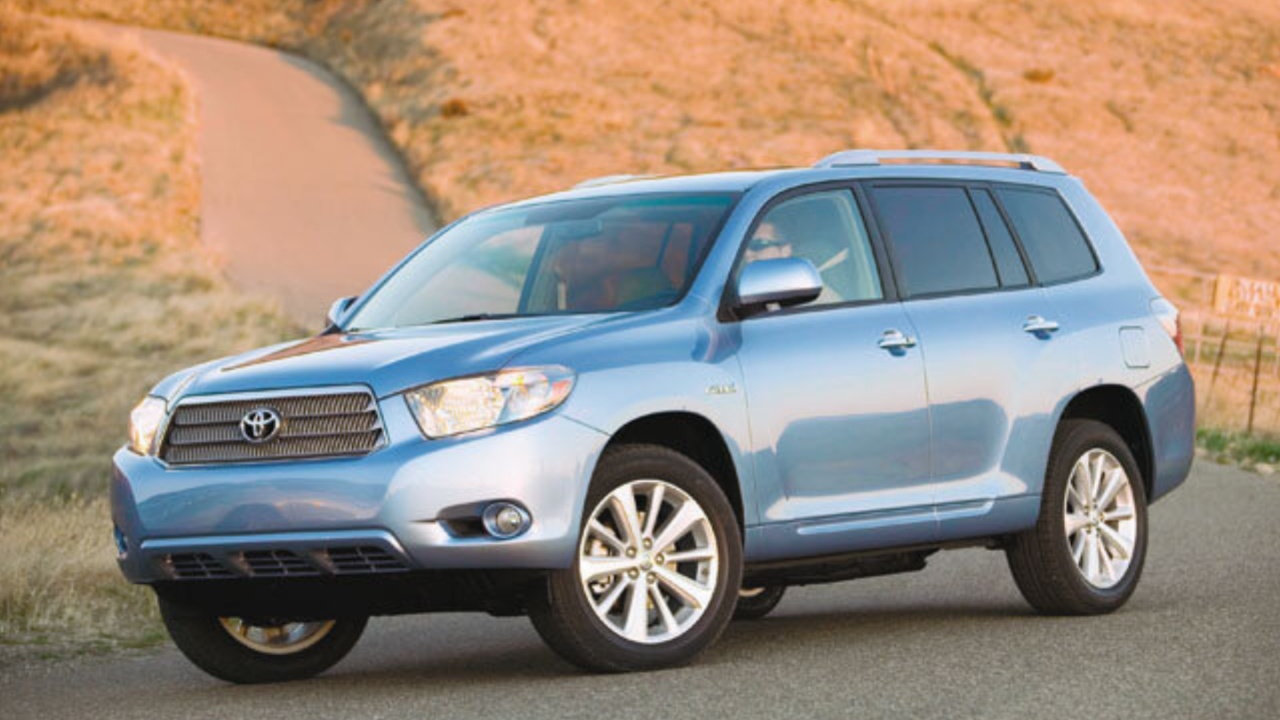
The 60/40 split design allows for flexible configuration, accommodating both additional passengers and longer cargo items simultaneously when needed.
When both sides are folded, the resulting cargo space offers a substantial, flat loading area that makes transporting everything from furniture to sporting equipment remarkably straightforward.
The Highlander enhances this functionality with a thoughtfully designed cargo area that includes additional storage compartments beneath the floor, providing secure spaces for smaller items that might otherwise roll around during transit.
The low lift-over height of the cargo area makes loading heavy or awkward items less physically demanding, while the available hands-free power liftgate on higher trims allows for easy access when your arms are full.
The standard tri-zone climate control extends air conditioning and heating to the third row, ensuring all passengers remain comfortable regardless of seating position.
Toyota has paid particular attention to the materials used in the third-row area, employing durable fabrics or leather depending on the trim level that can withstand the wear and tear associated with frequent folding and unfolding.
The mechanisms themselves utilize robust components designed for thousands of cycles without failure, reflecting Toyota’s commitment to long-term durability.
The seats lock securely in both their upright and folded positions, eliminating concerns about unexpected movement during driving or when loading cargo.
For families who value versatility without complication, the Highlander’s third-row design represents a significant advantage in daily use. The ease with which the space can be reconfigured means parents can quickly adapt to changing transportation needs whether accommodating additional children for carpool duty or creating space for weekend project supplies from the home improvement store.
This adaptability, combined with Toyota’s reputation for building vehicles that last for hundreds of thousands of miles, makes the Highlander a compelling option for growing families seeking a practical, long-term transportation solution that simplifies rather than complicates their busy lives.
3. Kia Telluride
The Kia Telluride has rapidly established itself as a standout in the midsize SUV segment since its introduction, earning multiple awards and changing perceptions about the Kia brand in the process.
Among its many thoughtfully designed features, the Telluride’s third-row seating system deserves special recognition for its exceptional ease of use and clever engineering that eliminates the need to remove or adjust headrests when folding the seats a convenience that becomes increasingly appreciated with regular use.
Kia’s engineers have implemented a sophisticated yet intuitive folding mechanism for the Telluride’s third row. The system utilizes a simple pull-strap design that triggers a multi-stage folding sequence: as you pull the marked strap, the headrest automatically pivots forward while simultaneously the seatback folds down, creating a completely flat load floor in one smooth motion.
This integration of the headrest into the folding mechanism represents a significant advancement over competitors that require manual headrest adjustment or removal, which can be particularly cumbersome when you’re already managing children, pets, or cargo.
Beyond the convenience of its folding mechanism, the Telluride’s third row stands out for being genuinely usable for adult passengers, a claim many three-row SUVs make but few deliver on.
With 31.4 inches of legroom, the third row can comfortably accommodate average-sized adults for more than just short trips. The seats themselves feature proper cushioning and angle, while the headrests, which so thoughtfully tuck away during folding, provide appropriate head support for taller passengers when the seats are in use.
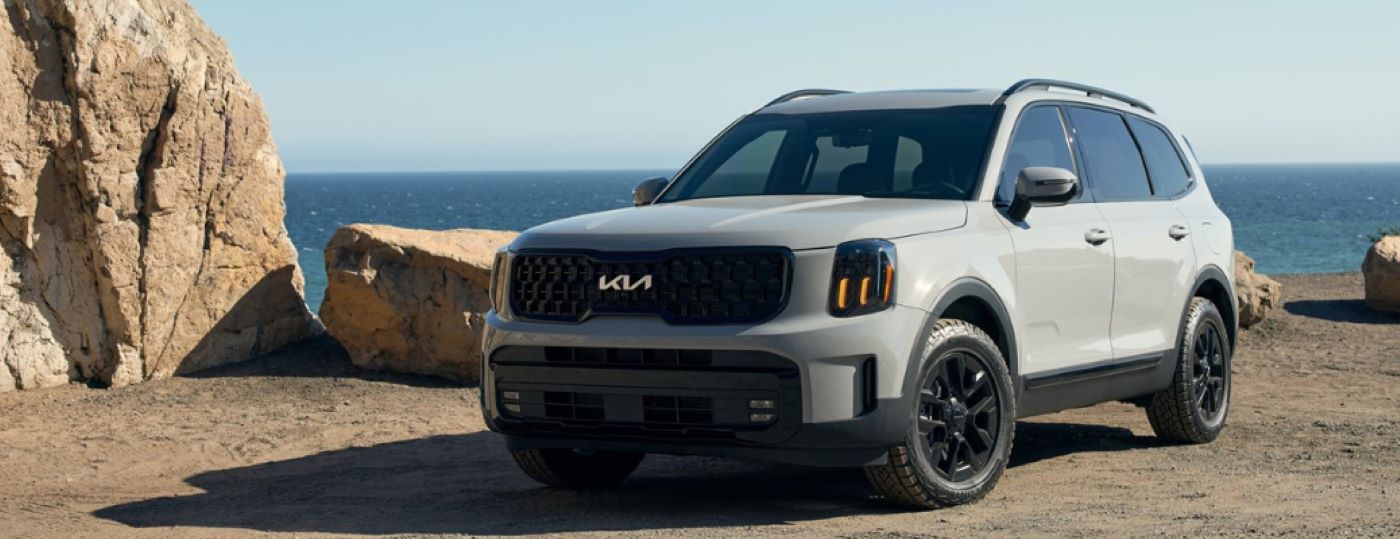
This attention to third-row passenger comfort reflects Kia’s understanding that a true family vehicle must serve all occupants well, not just those in premium positions.
The Telluride further enhances its third-row functionality with additional thoughtful touches throughout the rear of the vehicle. The 60/40 split configuration allows for flexible use of the space, accommodating both additional passengers and longer cargo when needed.
When both sections are folded, the resulting cargo area provides a substantial 46 cubic feet of storage space that expands to an impressive 87 cubic feet with the second row also folded.
The power liftgate available on higher trims includes smart opening functionality that automatically activates when it detects the key fob nearby for several seconds a helpful feature when approaching with arms full of groceries or luggage.
Kia has paid particular attention to the materials and construction quality of the third-row area. The seat upholstery, whether in the SX trim’s premium Nappa leather or the more utilitarian but still attractive cloth of lower trims, is designed for durability and easy cleaning, practical considerations for a space that will see frequent reconfiguration and potentially messy cargo.
The folding mechanisms themselves are constructed with robust materials and engineered for thousands of cycles without degradation, reflecting Kia’s confidence in the vehicle’s longevity as evidenced by their industry-leading warranty coverage.
For families who value both functionality and thoughtful design, the Telluride’s third-row implementation represents a significant advancement in everyday usability.
The elimination of headrest hassles may seem like a small detail on a spec sheet, but in the context of regular use, whether accommodating extra teammates after sports practice, loading up for a family road trip, or making room for home improvement supplies, it represents a tangible improvement in the ownership experience.
This attention to real-world usability, combined with the Telluride’s overall excellence in design, performance, and value, has helped cement its position as one of the most desirable three-row SUVs on the market today.
4. Ford Expedition
The Ford Expedition stands as a testament to American engineering when it comes to full-size SUVs, offering exceptional versatility and capability for large families and those requiring substantial passenger and cargo capacity.
Among its many impressive features, the Expedition’s third-row seating system deserves particular recognition for its remarkably user-friendly design that allows the seats to fold completely flat without requiring headrest removal, a convenience that proves invaluable in daily use scenarios.
Ford’s engineers have implemented an advanced power-folding mechanism for the Expedition’s third row that represents the pinnacle of convenience in this segment.
Accessible via buttons located in the cargo area, the system enables users to reconfigure the seating arrangement without even needing to open the rear doors.
With a simple press of clearly marked buttons, the third-row seats (including their integrated headrests) fold completely flat into the floor, creating a level cargo area in seconds.
This hands-off approach eliminates the physical effort typically required when manually folding seats and removes entirely the common frustration of dealing with headrests that must be removed and stored elsewhere in the vehicle.
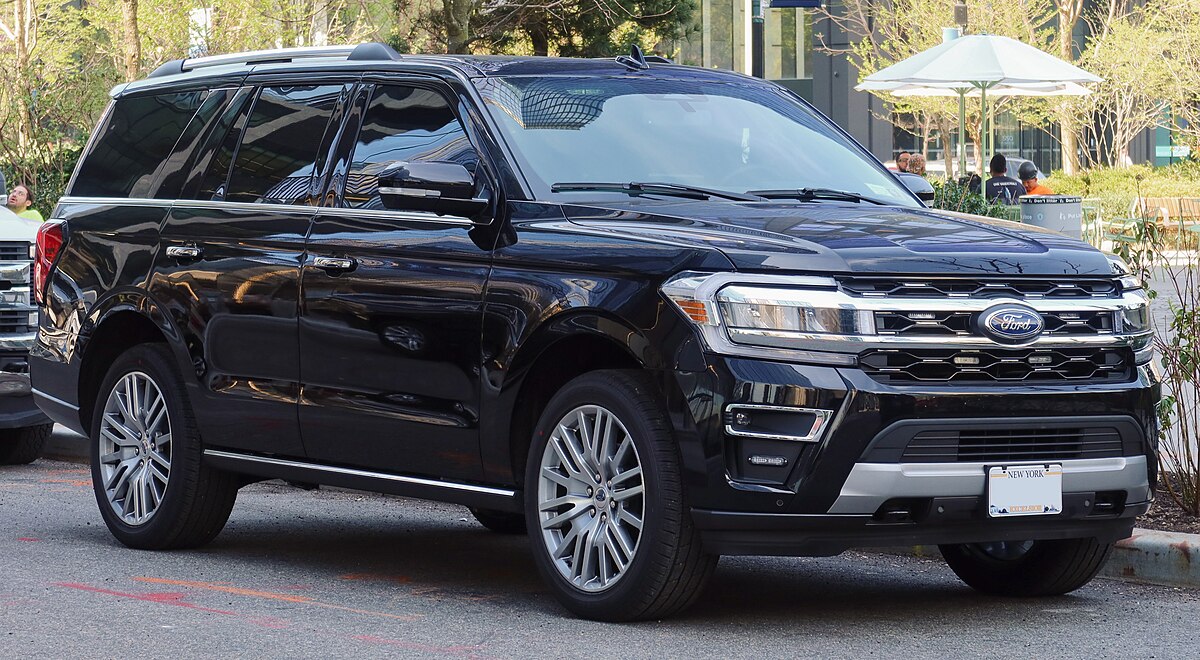
What truly distinguishes the Expedition’s third row is that it delivers this convenience without compromising passenger comfort. Unlike many competitors, where the third row feels cramped or compromised, Ford has allocated generous proportions to this often-neglected seating area.
With best-in-class legroom approaching 37 inches in the standard wheelbase model (and even more in the extended-length Expedition MAX), the third row can comfortably accommodate full-sized adults even on longer journeys.
The seats themselves feature proper cushioning and support, while the headrests which so cleverly integrate into the folding system are positioned at appropriate heights for passenger safety and comfort.
The Expedition enhances this functionality with its thoughtfully designed PowerFold system that offers multiple configuration options. The 60/40 split design allows for flexible use of the space, accommodating both additional passengers and longer cargo items simultaneously when needed.
When both sections are folded, the resulting cargo area provides a substantial flat floor that makes loading bulky items remarkably straightforward.
The power-deploying feature works equally well in reverse, allowing you to return the seats to their upright position without entering the vehicle particularly useful when arriving at your destination with additional passengers waiting to board.
Ford has further refined the cargo experience with the Expedition’s available hands-free, foot-activated liftgate that opens when you make a kicking motion beneath the rear bumper a thoughtful feature when approaching the vehicle with arms full.
The Cargo Management System includes adjustable shelving and dividers that help organize the substantial space created when the third row is folded, preventing smaller items from sliding around during transit.
Advanced features like Pro Trailer Backup Assist complement the Expedition’s impressive cargo capabilities, recognizing that many owners will use this space for gear associated with towing activities.
The materials and construction quality of the Expedition’s third-row area reflect the vehicle’s premium positioning within Ford’s lineup. The seat upholstery, whether in leather or the more utilitarian but still attractive cloth of lower trims, is engineered for durability and ease of cleaning, important considerations for a space that will frequently transition between passenger and cargo duties.
The power-folding mechanisms themselves utilize high-quality components designed for thousands of cycles without failure, an essential characteristic for a feature likely to see daily use in many households.
For families who require maximum versatility without complication, the Expedition’s third-row implementation represents the gold standard in user-friendly design.
The elimination of headrest hassles combined with power operation transforms what can be an awkward, physically demanding task in other vehicles into a simple push-button operation.
This attention to real-world usability, combined with the Expedition’s exceptional passenger space and towing capability, makes it an ideal choice for large, active families who refuse to compromise on convenience or capability.
Also Read: 8 Cars With Rear Center Armrests That Have Real Storage
5. Subaru Ascent
The Subaru Ascent represents the Japanese manufacturer’s successful foray into the three-row midsize SUV segment, bringing Subaru’s renowned all-wheel-drive expertise and safety focus to families requiring additional seating capacity.
Among the Ascent’s many family-friendly features, its intelligently designed third-row seating system stands out for its user-centric approach, allowing the seats to fold completely flat without the need to remove or separately adjust headrests, a convenience that enhances the vehicle’s overall versatility.
Subaru’s engineers have developed a thoughtfully integrated system for the Ascent’s third row that demonstrates their understanding of real-world family needs.
The folding mechanism employs a straightforward pull-strap design that initiates a coordinated movement: as the strap is pulled, the headrest automatically repositions itself as the seat folds down, creating a nearly flat load floor in one fluid motion.
This elegant solution eliminates the common annoyance of having to manually remove headrests before folding seats, a particularly welcome feature when you’re already managing children, pets, or cargo and need to quickly reconfigure your vehicle’s interior.
While not the largest in its class, the Ascent’s third row demonstrates a practical balance between passenger accommodation and overall vehicle footprint.
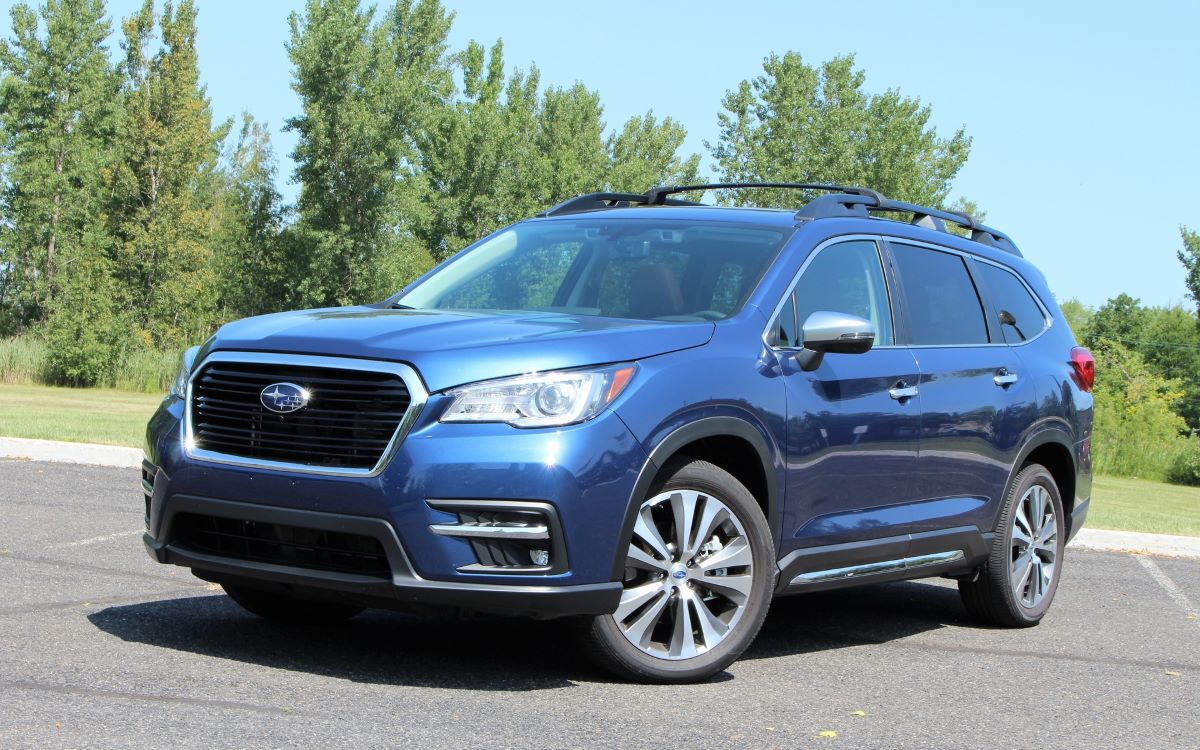
The 31.7 inches of third-row legroom provides adequate space for younger passengers and can accommodate average-sized adults for shorter trips, reflecting Subaru’s realistic approach to family transportation needs.
The 50/50 split design allows for flexible use of the space, enabling one side to remain upright for an additional passenger while the other is folded to accommodate longer cargo items.
When both sections are folded, they create a substantial cargo area that expands the available space from 17.8 cubic feet behind the third row to 47.5 cubic feet.
The Ascent enhances this functionality with thoughtful details throughout the rear cargo area. The low load floor height makes it easier to load heavy or bulky items, while the wide opening of the power rear gate (standard on all but the base trim) provides excellent access to the cargo space.
Subaru has incorporated 19 cup and bottle holders throughout the cabin an almost comical number that nonetheless reflects their understanding of family hydration needs on longer journeys.
Roof rails come standard across all trim levels, acknowledging that active families often need to transport gear that won’t fit inside even with seats folded.
Subaru has paid particular attention to the durability aspects of the third-row area. The seat upholstery, whether in cloth or the optional leather, is selected for its ability to withstand repeated use and easy cleaning, essential for a vehicle likely to transport children, pets, and outdoor equipment regularly.
The folding mechanisms themselves are engineered with Subaru’s typical focus on long-term reliability, using robust components designed to maintain proper operation throughout the vehicle’s lifespan.
The attention to detail extends to the cargo area’s side panels, which are made from materials resistant to scratches and dents from shifting cargo.
For families who value Subaru’s symmetrical all-wheel drive for all-weather capability but need more than five seats, the Ascent’s third-row implementation offers a compelling package that doesn’t force them to sacrifice convenience.
The elimination of headrest hassles represents a significant quality-of-life improvement during everyday use, whether accommodating an unexpected extra passenger, making room for weekly grocery shopping, or loading up sports equipment for weekend activities.
This practical approach to interior versatility, combined with Subaru’s industry-leading safety features and reputation for reliability, makes the Ascent a thoughtfully designed solution for active families navigating varied terrain and transportation needs.
6. Hyundai Palisade
The Hyundai Palisade has quickly established itself as a formidable competitor in the midsize three-row SUV segment since its introduction, offering a compelling blend of premium features, practical design, and excellent value.
Among its many family-oriented attributes, the Palisade’s third-row seating system deserves particular recognition for its exceptionally well-engineered design that allows the seats to fold completely flat without requiring headrest removal, a convenience that elevates the everyday ownership experience.
Hyundai’s engineers have implemented a sophisticated yet intuitive folding mechanism for the Palisade’s third row that demonstrates their commitment to user-centric design.
The system utilizes easily accessible pull straps that trigger a synchronized folding action: as you pull the marked strap, the headrest automatically adjusts its position while the seatback folds forward, creating a flat cargo floor in one smooth motion.
This integration of the headrest into the folding sequence represents thoughtful engineering that eliminates an often frustrating step in the process of reconfiguring vehicle interiors, particularly valuable when you’re already managing children, luggage, or purchases and need to quickly adapt your vehicle’s space.
What sets the Palisade apart from many competitors is that its third row doesn’t merely exist as a checkbox feature, it’s designed to be genuinely comfortable for passengers.
With 31.4 inches of legroom and good headroom, the third row can accommodate adult passengers in reasonable comfort even on longer journeys.
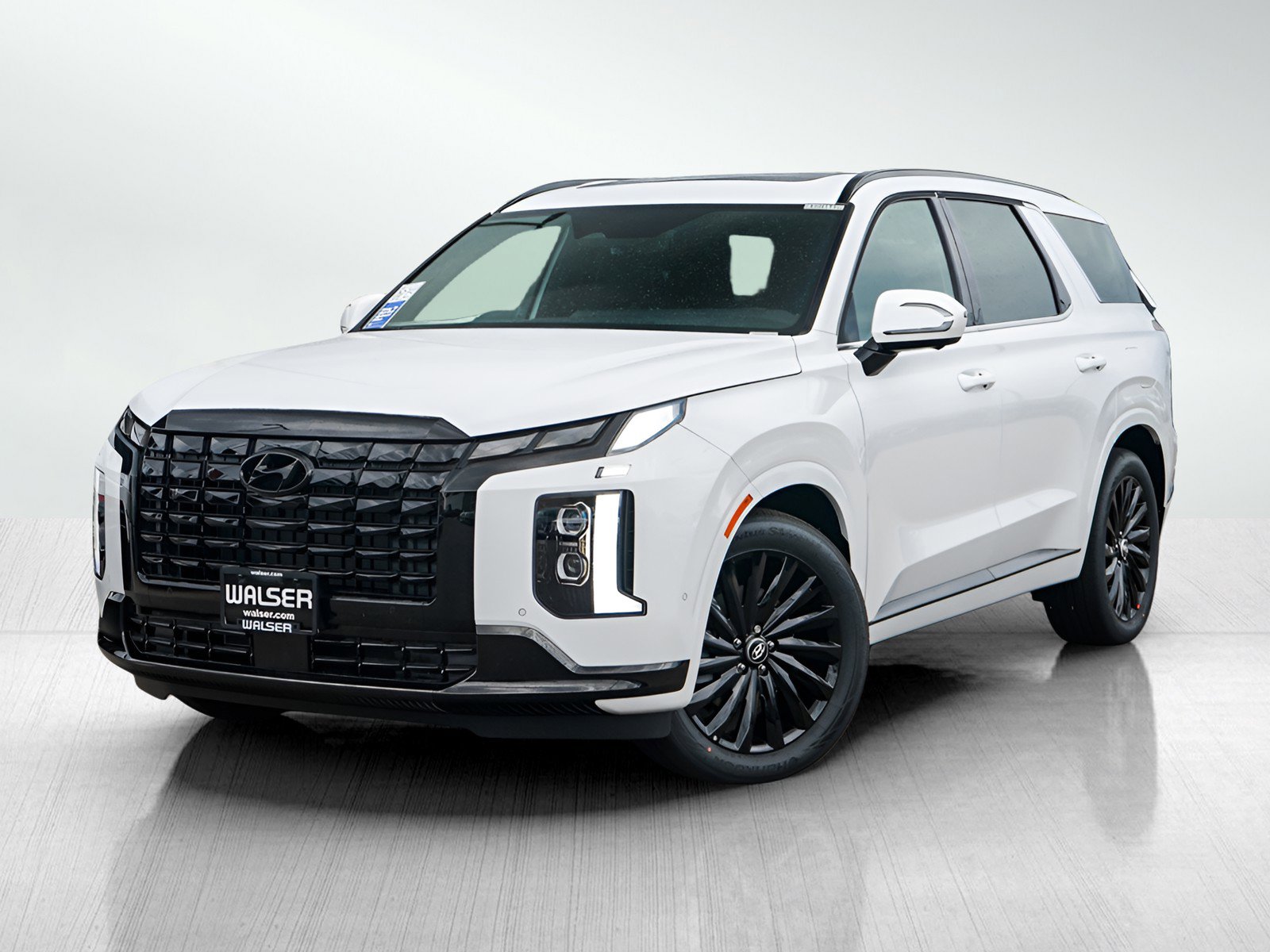
The seats themselves feature proper cushioning and support, while the headrests, which so conveniently integrate into the folding system, are positioned at appropriate heights for passenger safety and comfort when the seats are in use.
Power-folding functionality for the third row is available on higher trim levels, adding another layer of convenience for those who frequently reconfigure their vehicle’s interior.
The Palisade enhances its third-row functionality with a thoughtfully designed cargo area that includes underfloor storage compartments providing secure space for smaller items that might otherwise roll around.
The 60/40 split configuration allows for flexible use of the space, accommodating both additional passengers and longer cargo when needed. When both sections are folded, the resulting cargo area expands from 18 cubic feet behind the third row to 45.8 cubic feet, creating a substantial flat loading surface.
The hands-free smart power liftgate with auto-open functionality on higher trims recognizes when the key fob is nearby for several seconds and automatically opens, an incredibly useful feature when approaching with arms full of groceries or luggage.
Hyundai has paid particular attention to the materials and construction quality of the third-row area. The seat upholstery, whether in cloth on lower trims or the remarkably upscale Nappa leather on the Calligraphy trim, is selected for durability and ease of maintenance, practical considerations for a space that will frequently transition between passenger and cargo duties.
The folding mechanisms themselves utilize robust components designed for thousands of cycles without degradation, reflecting Hyundai’s confidence in their engineering as evidenced by their industry-leading warranty coverage.
The cargo area features thoughtful touches like bag hooks and tie-down anchors that help secure items when using the vehicle’s substantial cargo capacity.
For families who value both premium features and practical design, the Palisade’s third-row implementation represents a significant advancement in everyday usability.
The elimination of headrest hassles may seem like a minor detail when reviewing vehicle specifications, but in the context of regular use whether dropping off children at various activities, loading gardening supplies, or packing for a family vacation it represents a tangible improvement in the ownership experience.
This attention to real-world usability, combined with the Palisade’s overall excellence in design, comfort, and value, helps explain why it has so quickly become a favorite among discerning family buyers seeking a three-row SUV that doesn’t compromise on convenience or refinement.
7. Mazda CX-90
The Mazda CX-90, positioned as the flagship of Mazda’s SUV lineup, represents the brand’s upmarket evolution while maintaining its driver-focused DNA.
Among its many premium features, the CX-90’s third-row seating system deserves special attention for its exceptional engineering that allows the seats to fold flat without requiring headrest removal, a convenience that aligns perfectly with Mazda’s philosophy of creating vehicles that satisfy both emotional and practical needs.
Mazda’s engineers have developed a remarkably refined system for the CX-90’s third row that demonstrates their attention to detail and commitment to thoughtful design.
The folding mechanism employs an intuitive strap-pull design that initiates a carefully orchestrated sequence: as the strap is pulled, the headrest automatically repositions itself while the seatback folds forward, creating a nearly flat load floor in one smooth, controlled motion.
This integration of the headrest into the folding sequence represents sophisticated engineering that eliminates an often frustrating step in the process of reconfiguring vehicle interiors, particularly valuable in daily use scenarios when time and convenience matter.
What distinguishes the CX-90’s third row is how it balances practical functionality with Mazda’s premium aspirations. While not the largest in its class, Mazda has prioritized exterior proportions that maintain the brand’s distinctive styling and driving dynamics. The third row provides usable space for younger passengers and can accommodate adults for shorter journeys.
The 50/50 split design allows for flexible use of the space, enabling one side to remain upright for an additional passenger while the other is folded to accommodate longer cargo items.
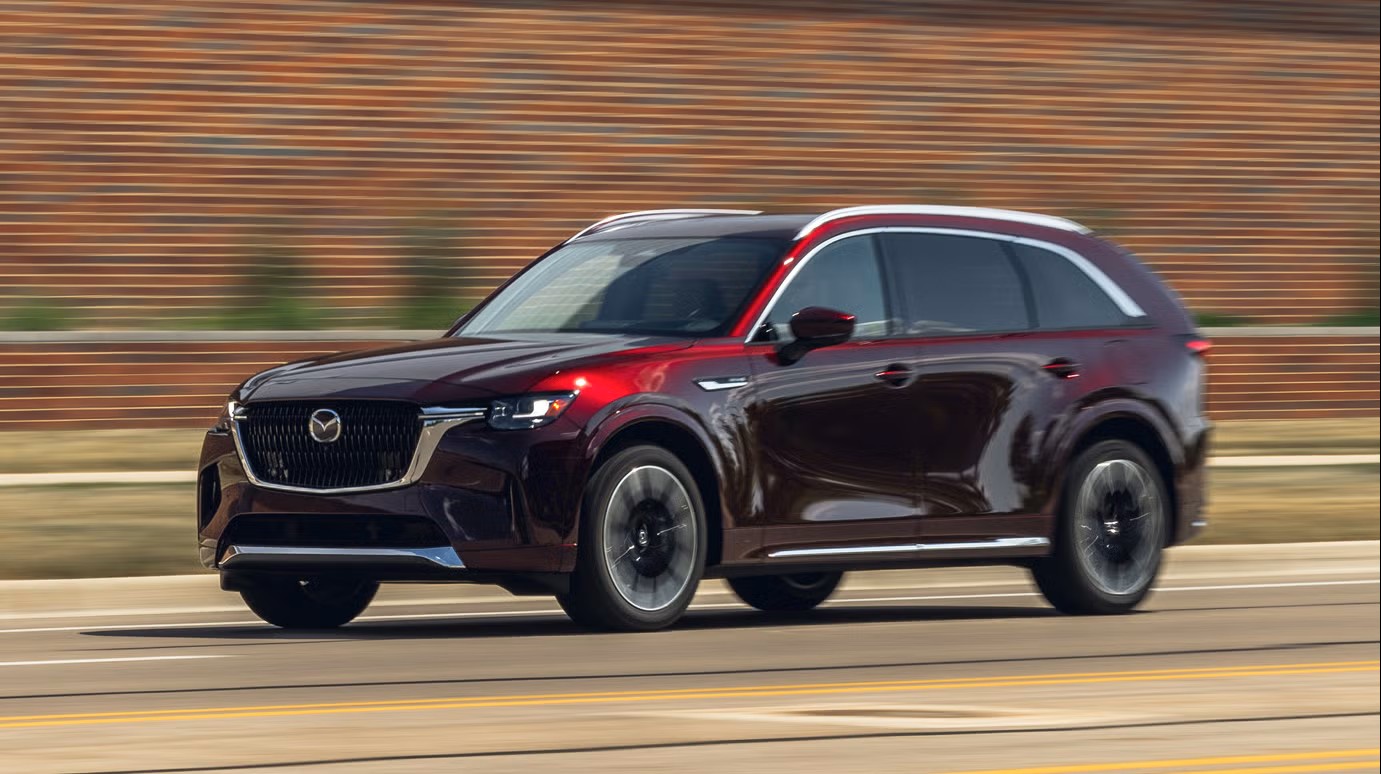
When both sections are folded, they create a substantial cargo area that significantly expands the available space from behind the third row. The CX-90 enhances this functionality with premium touches throughout the rear cargo area that reflect Mazda’s upscale positioning.
The low liftover height makes loading heavy or awkward items less physically demanding, while the available power liftgate includes programmable height adjustment a thoughtful feature for users of different heights or garages with low ceilings.
Mazda has incorporated high-quality materials throughout the cargo area, with carpeting and trim pieces that match the premium feel of the passenger cabin a detail often overlooked by competitors.
The precision with which the seats fold and the solidity of the resulting cargo floor demonstrate Mazda’s obsessive attention to build quality. Mazda has taken particular care with the materials and construction quality of the third-row area.
The seat upholstery, whether in cloth on lower trims or the sumptuous leather options on higher specifications, is selected not just for appearance but for durability and ease of maintenance important considerations for surfaces that will experience regular folding and unfolding.
The mechanisms themselves utilize high-quality components engineered for smooth operation throughout thousands of cycles, reflecting Mazda’s focus on engineering excellence and long-term reliability.
The attention to detail extends even to the sound the seats make when folding, a satisfying, substantial thunk rather than the plastic clatter common in less carefully engineered vehicles.
For families who refuse to compromise on driving enjoyment or premium feel when selecting a three-row vehicle, the CX-90’s third-row implementation offers a compelling package that enhances rather than detracts from the ownership experience.
The elimination of headrest hassles represents a significant quality-of-life improvement during everyday use, whether accommodating occasional extra passengers, transporting bulky purchases, or loading recreational equipment for weekend adventures.
This thoughtful approach to interior versatility, combined with Mazda’s distinctive driving dynamics and upscale interior ambiance, makes the CX-90 a sophisticated choice for discerning families who want their practical family vehicle to deliver more than mere functionality.
8. Volkswagen Atlas
The Volkswagen Atlas has carved out a distinct position in the midsize three-row SUV segment since its introduction, offering Germanic engineering sensibilities with American-sized proportions.
Among its many family-friendly attributes, the Atlas’s third-row seating system deserves particular recognition for its exceptionally well-executed design that allows the seats to fold completely flat without requiring headrest removal, a convenience that enhances the vehicle’s overall versatility and ease of use.
Volkswagen’s engineers have implemented a thoughtfully designed folding mechanism for the Atlas’s third row that demonstrates their understanding of real-world family needs.
The system utilizes easily accessible pull straps that initiate a synchronized folding action: as you pull the marked strap, the headrest automatically repositions itself while the seatback folds forward, creating a flat cargo floor in one fluid motion.
This integration of the headrest into the folding sequence represents elegant engineering that eliminates an often frustrating step in reconfiguring vehicle interiors, particularly valuable when you’re already managing children, pets, or cargo and need to quickly adapt your vehicle’s space.
What distinguishes the Atlas from many competitors is its genuinely useful third-row dimensions, reflecting Volkswagen’s commitment to creating a true seven-passenger vehicle rather than a technical seven-seater.
With adult-friendly legroom and headroom, the Atlas’s third row can accommodate passengers of various sizes in reasonable comfort even on longer journeys.
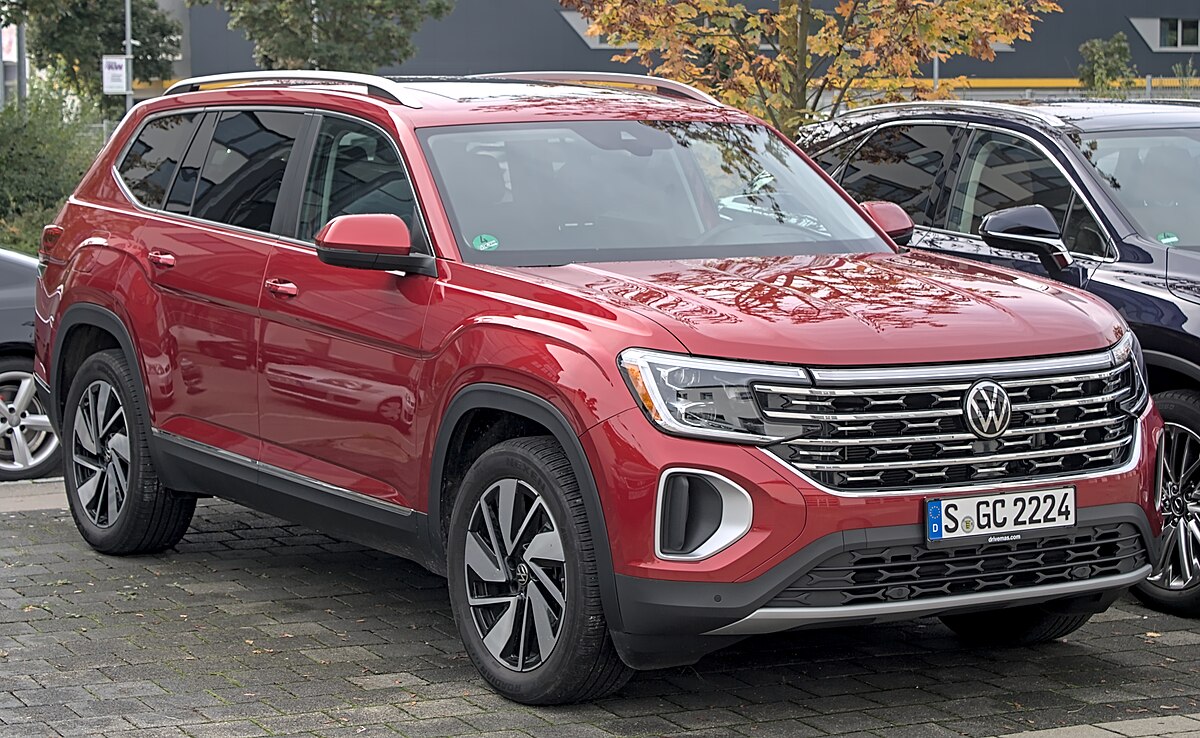
The seats themselves feature proper cushioning and support, while the headrests which so conveniently integrate into the folding system are positioned at appropriate heights for passenger safety and comfort when the seats are in use.
The thoughtful design extends to access as well, with second-row seats that tilt and slide forward easily, creating a generous pathway to the third row a detail that parents of younger children particularly appreciate.
The Atlas enhances this functionality with a remarkably well-designed cargo area that maximizes usability. The 50/50 split third row provides flexible configuration options, accommodating both additional passengers and longer cargo when needed.
When both sections are folded, the resulting cargo area expands dramatically from 20.6 cubic feet behind the third row to 55.5 cubic feet, creating a substantial flat loading surface ideal for bulky items.
The hands-free power liftgate available on higher trims adds another layer of convenience, opening automatically when you make a kicking motion beneath the rear bumper, particularly useful when approaching with arms full of groceries, sports equipment, or home improvement supplies.
Volkswagen has paid particular attention to the materials and construction quality of the third-row area, reflecting its engineering-focused heritage.
The seat upholstery, whether in V-Tex leatherette or genuine leather, depending on trim level, is selected for durability and ease of maintenance practical considerations for surfaces that will experience frequent folding and unfolding.
The mechanisms themselves utilize robust components designed for thousands of cycles without degradation, incorporating the same attention to long-term durability that characterizes Volkswagen’s approach to mechanical systems.
The cargo area features thoughtful touches like bag hooks and tie-down points that help secure items when utilizing the vehicle’s substantial cargo capacity.
For families who value both space efficiency and European design sensibilities, the Atlas’s third-row implementation represents a significant advancement in everyday usability.
The elimination of headrest hassles may seem like a minor detail when reviewing vehicle specifications, but in the context of regular use whether accommodating carpool arrangements, hauling home improvement materials, or packing for family vacations it represents a tangible improvement in the ownership experience.
This attention to real-world functionality, combined with the Atlas’s exceptional interior dimensions and clean, understated design aesthetic, makes it a compelling option for practical-minded families seeking a three-row SUV that prioritizes substance over flash while still delivering meaningful convenience features.
9. Chevrolet Traverse
The Chevrolet Traverse stands as a quintessential American interpretation of the three-row crossover SUV, offering exceptional interior space within reasonably manageable exterior dimensions.
Among its many family-oriented virtues, the Traverse’s third-row seating system deserves particular acclaim for its remarkably user-friendly design that allows the seats to fold completely flat without requiring headrest removal, a convenience that significantly enhances the vehicle’s versatility in daily use scenarios.
Chevrolet’s engineers have developed a thoughtfully integrated system for the Traverse’s third row that demonstrates their understanding of practical family transportation needs.
The folding mechanism employs a straightforward pull-strap design that initiates a coordinated movement: as the marked strap is pulled, the headrest automatically repositions itself while the seatback folds forward, creating a flat load floor in one smooth motion.
This elegant solution eliminates the common annoyance of having to manually remove headrests before folding seats, a particularly welcome feature when you’re already managing children, groceries, or sports equipment and need to quickly reconfigure your vehicle’s interior space.
What truly distinguishes the Traverse in its segment is the exceptional spaciousness of its third row, a feature that elevates it from merely having a third row to offering a genuinely useful one.
With adult-friendly dimensions that include approximately 33.5 inches of legroom, the Traverse’s third row can comfortably accommodate full-sized passengers even on longer journeys a claim many three-row vehicles make but few deliver on.
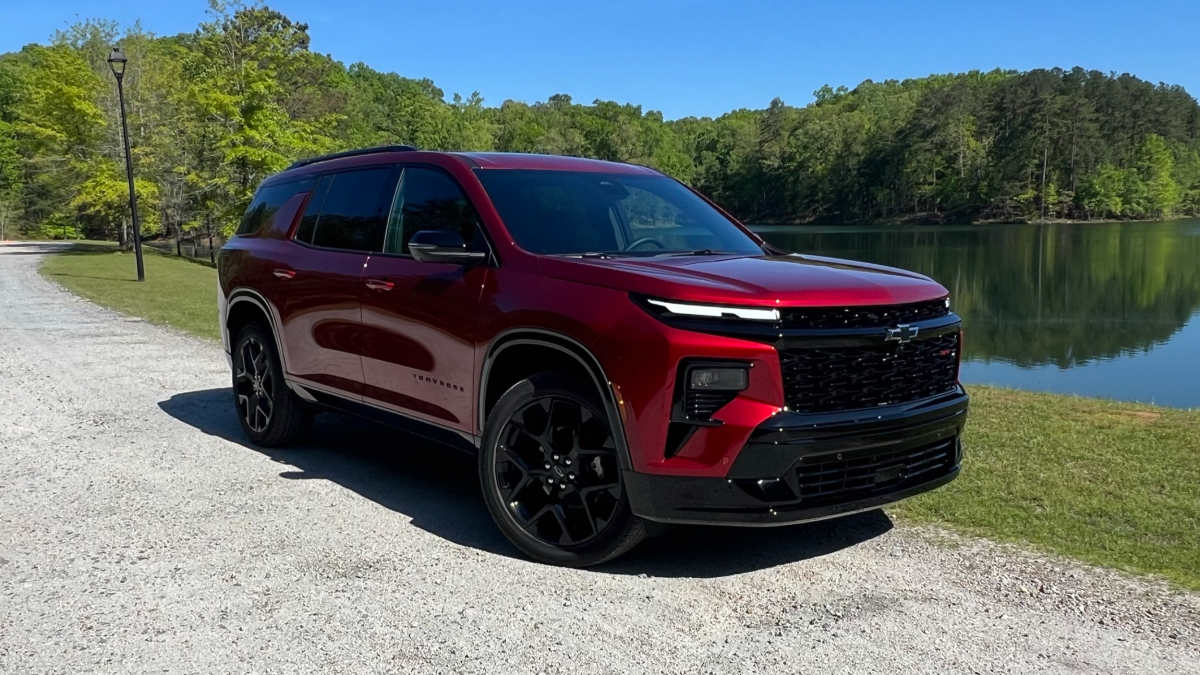
The seats themselves feature proper cushioning and support, while the headrests, which so cleverly integrate into the folding system, are positioned at appropriate heights for passenger safety and comfort when the seats are in use.
This attention to third-row passenger accommodation reflects Chevrolet’s understanding that a true family vehicle must serve all occupants well, not just those in premium positions.
The Traverse enhances this functionality with its thoughtfully designed cargo area that maximizes versatility. The 60/40 split third row provides flexible configuration options, accommodating both additional passengers and longer cargo when needed.
When both sections are folded, the resulting cargo area expands dramatically from 23 cubic feet behind the third row to an impressive 57.8 cubic feet, creating a substantial flat loading surface ideal for bulky items.
The available hands-free power liftgate with programmable height adjustment adds another layer of convenience, a thoughtful feature when approaching with arms full or when parking in garages with low ceilings.
Chevrolet has paid particular attention to the accessibility aspects of the third-row area. The Smart Slide second-row seating tilts and slides forward with remarkable ease, creating a generous pathway to the third row even when child seats are installed in the second row (though the child seat must be unoccupied), a feature parents of young children particularly appreciate.
The third-row seats themselves can be returned to their upright position with minimal effort, featuring well-designed mechanisms that don’t require exceptional strength or awkward body positioning.
These thoughtful touches recognize that ease of use significantly impacts how frequently various seating configurations will be utilized in real-world conditions.
The materials and construction quality of the Traverse’s third-row area reflect Chevrolet’s focus on durability for family use. The seat upholstery, whether in cloth on lower trims or the more premium leather options on higher specifications, is selected for resilience and ease of cleaning essential for a vehicle likely to transport children, pets, and various cargo regularly.
The folding mechanisms themselves utilize robust components designed for thousands of cycles without failure, incorporating the same engineering principles that characterize Chevrolet’s approach to long-term reliability.
The cargo area features thoughtful touches like storage compartments and tie-down points that help organize and secure items when utilizing the vehicle’s substantial cargo capacity.
For families who prioritize interior space and practical versatility, the Traverse’s third-row implementation represents a significant advancement in everyday usability.
The elimination of headrest hassles may seem like a small detail on a spec sheet, but in the context of regular use, whether accommodating carpool arrangements, transporting home improvement materials, or packing for family road trips, it represents a tangible improvement in the ownership experience.
This attention to real-world functionality, combined with the Traverse’s exceptional passenger and cargo dimensions, makes it a compelling option for larger families seeking maximum utility without moving up to a full-size SUV.
10. Jeep Grand Cherokee L
The Jeep Grand Cherokee L represents a significant evolution of the iconic Grand Cherokee nameplate, extending its appeal to larger families requiring three-row seating while maintaining Jeep’s renowned off-road capabilities.
Among its many premium attributes, the Grand Cherokee L’s third-row seating system deserves particular recognition for its exceptionally well-executed design that allows the seats to fold completely flat without requiring headrest removal, a convenience that enhances the vehicle’s overall versatility without compromising its adventure-ready character.
Jeep’s engineers have implemented a sophisticated folding mechanism for the Grand Cherokee L’s third row that demonstrates their attention to detail and understanding of practical luxury.
The system utilizes easily accessible release levers that trigger a synchronized folding action: as the lever is activated, the headrest automatically adjusts its position while the seatback folds forward, creating a flat cargo floor in one smooth, controlled motion.
This integration of the headrest into the folding sequence represents thoughtful engineering that eliminates an often frustrating step in the process of reconfiguring vehicle interiors, particularly valuable when you’re already managing family members, outdoor gear, or purchases and need to quickly adapt your vehicle’s space.
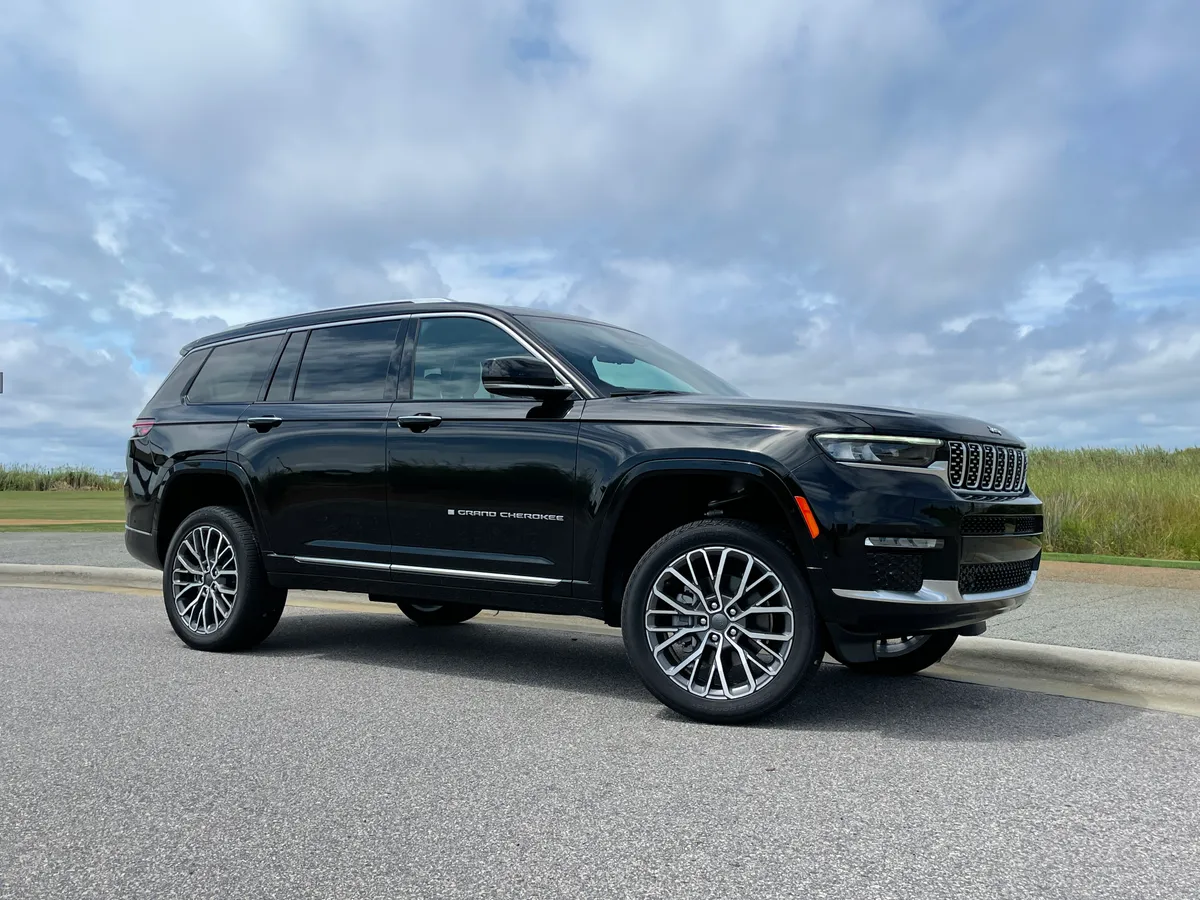
What distinguishes the Grand Cherokee L’s third row is how it balances practical functionality with Jeep’s premium aspirations in this extended model.
With reasonable dimensions that include approximately 30.3 inches of legroom, the third row provides adequate space for younger passengers and can accommodate adults for shorter journeys, reflecting Jeep’s realistic approach to creating a vehicle that prioritizes capability and luxury while adding family-friendly versatility.
The 50/50 split design allows for flexible use of the space, enabling one side to remain upright for an additional passenger while the other is folded to accommodate longer cargo items
When both sections are folded, they create a substantial cargo area that expands the available space from 17.2 cubic feet behind the third row to 46.9 cubic feet, providing considerable room for adventure gear, luggage, or everyday cargo needs.
Also Read: 10 Trunk Designs That Let Water In When Open

